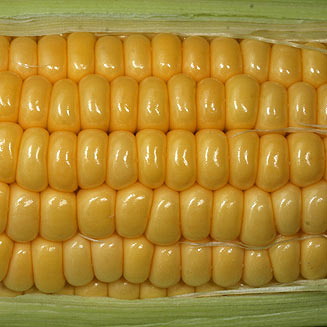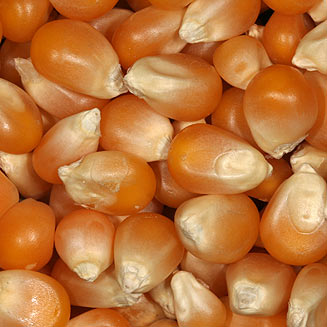Zea mays (Maize, Corn)
Mielie [Afrikaans] Life
> eukaryotes >
Archaeoplastida >
Chloroplastida
>
Charophyta > Streptophytina > Plantae (land plants)
> Tracheophyta (vascular plants) > Euphyllophyta > Lignophyta (woody plants)
> Spermatophyta (seed plants) > Angiospermae (flowering
plants) > Monocotyledons > Order: Poales
> Family: Poaceae
Maize was domesticated in Mexico about 7000 years ago and by the time Columbus
arrived in the New World, there were already many varieties. It was introduced
to Africa in the 16th century and over time came to replace
sorghum as the staple food in all but the
drier areas.
History of domestication
There are four wild species in the genus Zea, all of which are native
to Mexico and northern Central America. One of these, Zea
mexicana, commonly called teosinte, gave rise to maize Zea mays. Genetic
evidence suggests that maize originated mainly from the Balsas race
of teosinte which is found in the Balsas River basin in the Michoacan-Guerrero
border region of western Mexico. Zea mays is thought to have speciated
from Z. mexicana into a separate gene pool many thousands of years ago
afterwhich it diversified into a number of different races.
Maize is similar to teosinte in that it is a quick growing annual with C4-type
photosynthesis, giving it the ability to grow well in bright sunlight with
limited water, and it has unisexual inflorescences: the tassel (male) and the
ear (female).
Maize is different from teosinte in a number of features including:
- loss of the hard case around the grain which in teosinte helps grain to
survive going through an animal's digestive system;
- doubling and redoubling of the two rows of grain in the teosinte ear; and
- the maize ear is covered by husks, with elongated styles sticking out the
tip of the ear for pollination.
- larger grain size, loss of dormancy and retention of ripe grain on the ear
that does not shatter (all typical features of grass domestication)
Archaeological evidence from the Tehuacan caves in Puebla, Mexico, suggests
that people were using Z. mays rather that Z. mexicana from about
5000 BC. The remains of Z. mays from these caves still bare quite a close
resemblance to Z. mexicana in that the ears are small and slender and the
grains are tiny and hard. However,
the cobs were non-shattering and there were mostly eight row of kernels although
there were a few four rowed types. They were probably used to produce popcorn. By the time Columbus arrived in the Americas,
people had developed numerous forms of maize and were often growing them in
close proximity to one another. Although maize is wind-pollinated, people were
able to keep races genetically distinct because (1) different races were grown
in different fields with forest in between; (2) pollen of the same race as the
plant tends to grow down the long styles faster than pollen of different races;
and (3) farmer can spot a cob with pollination by different races of pollen
because grains are often differently coloured - cobs like this would be rejected
for planting.
Columbus brought maize grains back to the Spanish court,
originating from the Greater Antilles in the Caribean, and these were grown in
Spain in 1493. Basque companions of Pizarro brought maize grains back from Peru
and introduced maize growing to the Pyrenees. Maize growing spread rapidly in
Europe although only in southern Europe did it become a major crop. The
popularity of maize in this region stemmed from the increased yield it provided
over other spring crops such as wheat. It soon became the staple diet of poor
people which led to malnutrition because maize is deficient in the amino acids
lysine and niacin and white maize is deficient in carotene which is converted
to Vitamin A. The disease pellagra became common, caused by a deficiency of
niacin.
Maize was introduced to Africa in the 16th and 17th
centuries and was readily accepted by African farmers, partly because it was
grown and used in a similar way to their traditional crop of grain
sorghum. Maize displaced sorghum as the staple grain in all but the drier
regions. The Portuguese are thought to have introduced maize to Asian regions
where it became widely grown but in most cases did not replace rice and wheat as
the major crops.
In North America, the Red Indian tribes were growing maize
as far back as 200 AD, but it was only in the 19th Century, with the aid of
draft animals and ploughs, that European settlers rapidly developed the prairie
grasslands of the Eastern US into what is now referred to as the Cornbelt. It
was in this region that new, higher yielding maize varieties were developed,
some of which were adopted in other parts of the world.
 |
 |
|
Corn on the cob is cooked and eaten as a
vegetable. [photo H. Robertson, Iziko ©] |
Popcorn kernels. Popcorn is a variety of Zea
mays with seeds that puff out into popcorn when heated. [photo H.
Robertson, Iziko ©] |
References
-
Sauer, J.D. 1993. Historical geography of
crop plants - a select roster. CRC Press, Boca Raton, Florida.
Text by Hamish Robertson |
